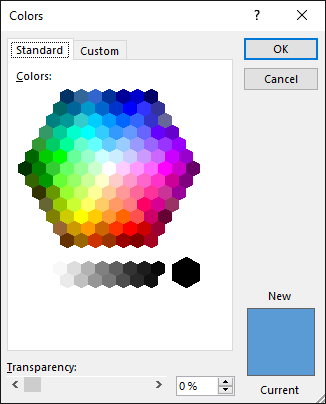Whenever a new shape is inserted on a slide in PowerPoint 2016, it is filled by default with a solid color (or something else depending on the Theme your presentation is based on). Other than a solid fill type, PowerPoint 2016 provides several more options that let you fill a shape with a picture, a gradient, a pattern, or a texture, and we have explored these other fill options in our Fills for Shapes in PowerPoint 2016 tutorial. In this tutorial, we'll show you how you can work with solid color fills.
Follow these steps to change the fill of a shape to a solid color of your choice:
- Open your presentation and select the shape that you want to format.
- Alternatively, if you want to start from scratch, launch PowerPoint. You will see the Presentation Gallery, select the Blank Presentation option to open a blank presentation with a new slide. You can change the Slide Layout to Blank by selecting the Home tab | Layout | Blank option. Then, insert a shape and select it.
- We selected a Star shape, as shown in Figure 1. Selecting the shape brings up the Drawing Tools Format tab in the Ribbon, as shown highlighted in red within Figure 1. Activate this Ribbon tab by clicking on it.

Figure 1: Drawing Tools Format tab of the Ribbon Note: The
Drawing Tools Format tab is a
Contextual tab. These tabs are special tabs in the
Ribbon that are not visible all the time, they only make an appearance when you are working with a particular slide object which can be edited using special options.
- Within the Drawing Tools Format tab, click the right-side portion of the Shape Fill button (highlighted in red within Figure 2). This brings up the Shape Fill drop-down gallery, as shown in Figure 2.

Figure 2: Shape Fill drop-down gallery - The options within the Shape Fill drop-down gallery are explained below, as marked in Figure 2, above. You'll need to choose any one of these options for the fill:
A. Theme Colors
- Here you can select any of the colors which are from the active Theme of the presentation. You can also select any of the 5 tints or shades for any Theme color. Learn more about Themes here.
B. Standard Colors
- Here you can choose from any of the ten standard colors, these ten standard colors are just choices of colors that PowerPoint believes to be widely used. You don't have to limit yourself to either the Theme colors or Standard colors, as you'll learn in the next options, although it's a good design idea to use Theme colors as far as possible.
C. Recent Colors
- Here you can find the colors most recently used. If you have just launched PowerPoint and created a new presentation, the Recent Colors option may be entirely absent since you haven't selected any color recently!
D. No Fill
- Choose this option to remove any fill from the selected shape.
E. More Fill Colors
- This option is to summon the Colors dialog box as shown in Figure 3. This dialog box has two tabs: Standard and Custom, first select the Standard tab (again, refer to Figure 3).

Figure 3: Standard tab within the Colors dialog box - The Standard tab offers 127 colors in a honeycomb style palette, 14 gray shades, black and white. You can even change the transparency value of the selected color in the Transparency slider below. If you want more color choices, then select the Custom tab of the same dialog box, as shown in Figure 4.

Figure 4: Custom tab within the Colors dialog box - Within the Custom tab, you can chose any color from the spectrum and later adjust the selected color's luminosity with the slider on the right. You can even enter specific values of RGB and HSL to create a specific color, all these combinations provide 16 million color choices!
- Again, you can even change the transparency value of the selected color in the Transparency slider below.
- Choose any color and click OK to apply it.
F. Eyedropper
- This option enables you to pick an exact color from anywhere, sometimes even from somewhere outside PowerPoint. Explore our Eyedropper Option in PowerPoint 2016 tutorial to learn more.
G. Picture
- This option allows to use a picture as a fill for a shape. Learn more in our Add Picture Fills to Shapes in PowerPoint 2016 tutorial.
H. Gradient
- With this option, you can apply a gradient as a fill for a shape. Learn more in our Add Gradient Fills to Shapes in PowerPoint 2016 tutorial.
I. Texture
- Use this option to apply a texture as a fill for a shape. Learn more in our Add Texture Fills to Shapes in PowerPoint 2016 tutorial.
- Choose any color from the Theme Colors (or its shades and tints), Standard Colors, Recent Colors, or from More Colors. In all cases, you end up with a shape that has a solid color fill, as shown in Figure 5 below.

Figure 5: Shape with changed solid fill - Remember to save your presentation often.





